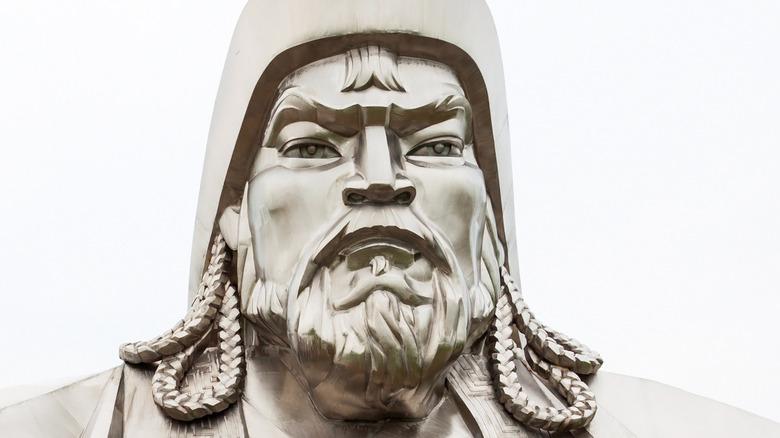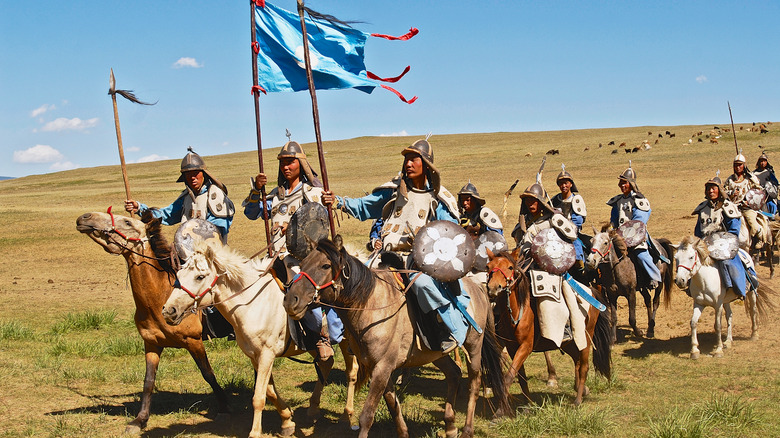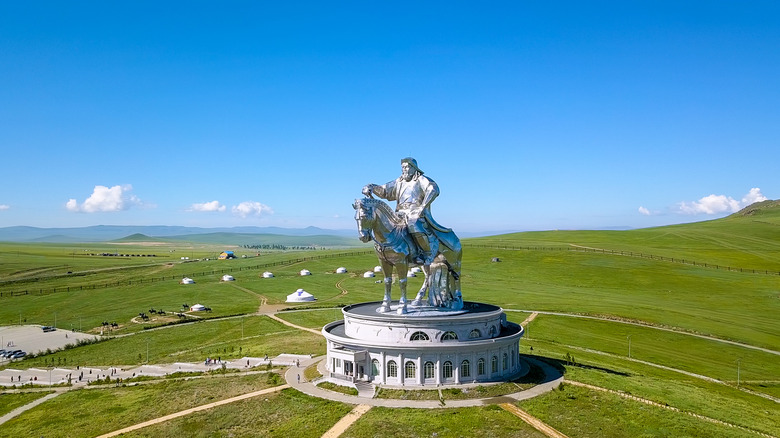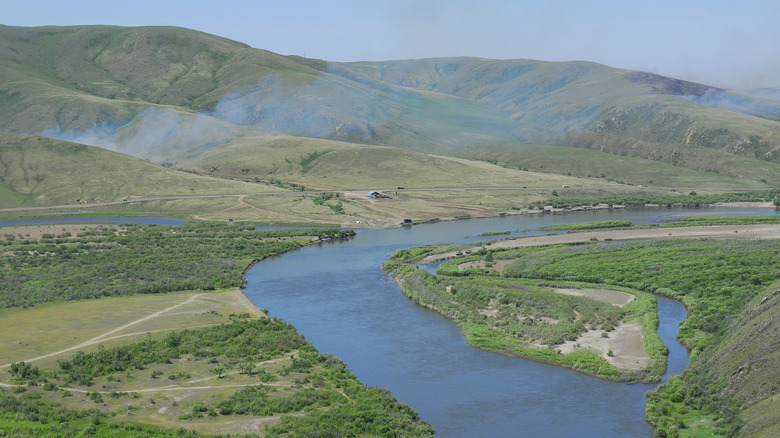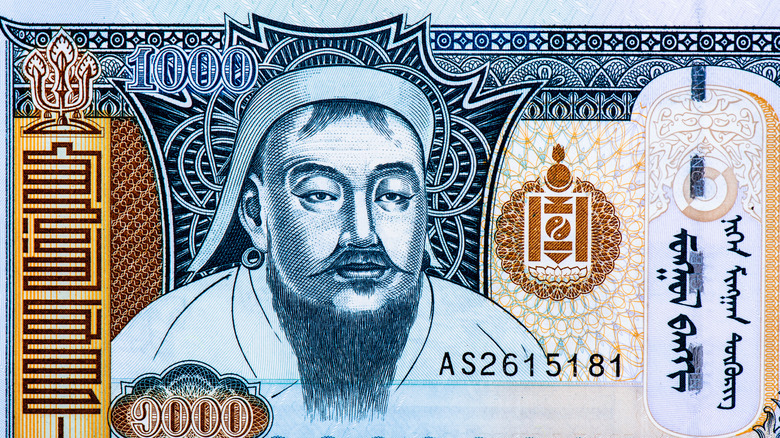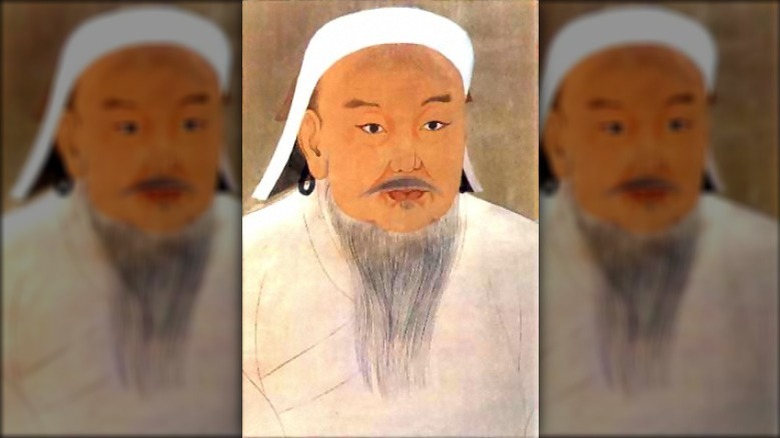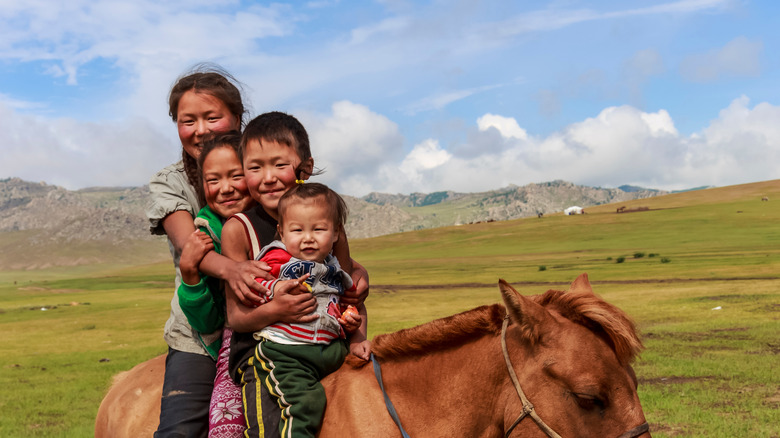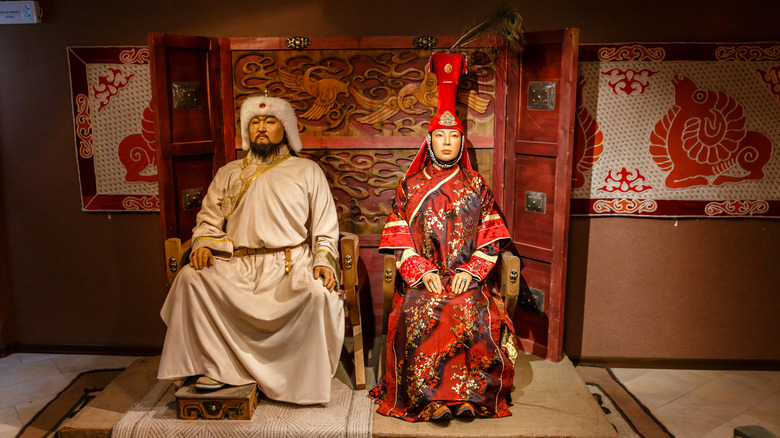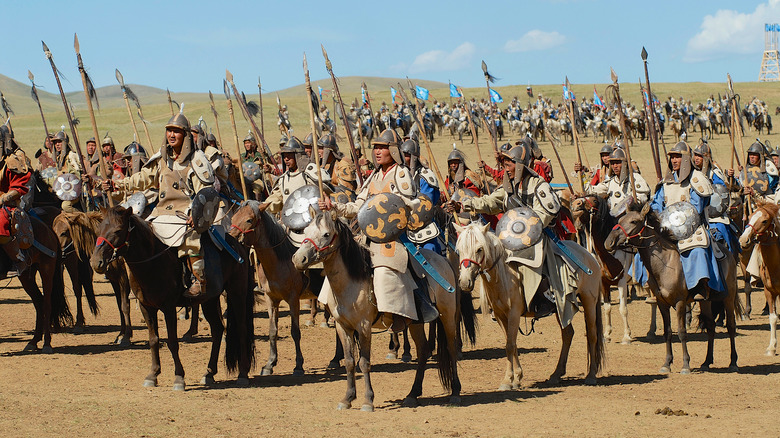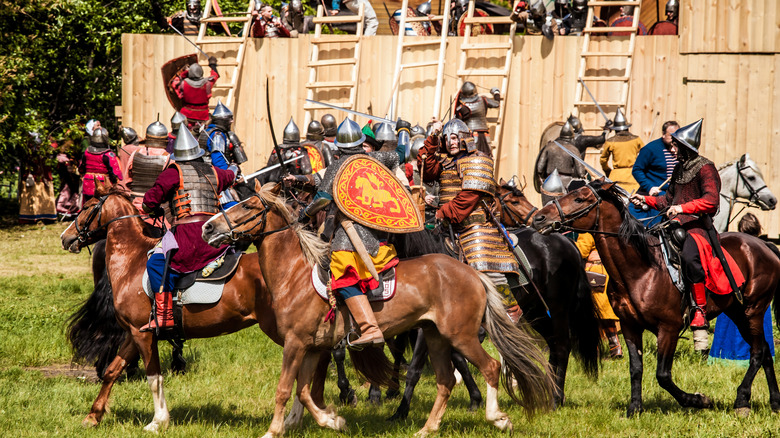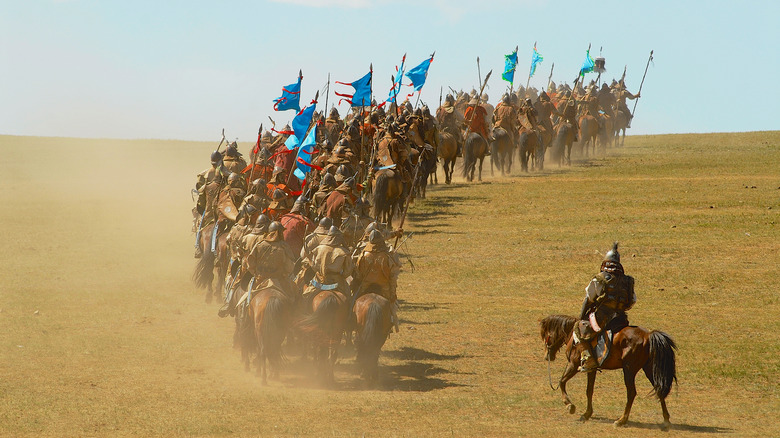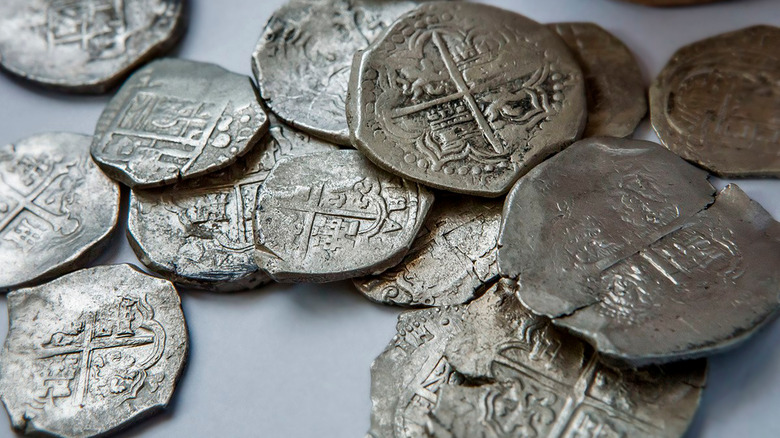Details About Genghis Khan That Remain A Mystery
How would you like to conquer the world? Genghis Khan sure did. This Mongol ruler was arguably the greatest conqueror in history, or at least he makes it into the top two competing with Alexander the Great. But unlike Alexander — who inherited his position from his father — Genghis Khan pulled himself up by his own stirrups. Britannica notes his achievements: Not only did he unite the fractious steppe people of Mongolia, but in the early 13th century CE, he laid the foundation for an empire that extended from the Pacific coast of China right to the Adriatic Sea in Europe. It was the largest contiguous land empire in history. Today, Genghis Khan is a national hero and icon in Mongolia, even featured on their currency. Of course, his more terrible aspects, such as killing and subjugating millions upon millions of people, go largely ignored when celebrating the Khagan's (Khan of Khans) birthday.
What is most unusual about Genghis Khan is that somebody so important to the pageant of world history, somebody who is the equivalent of an extinction event comet, has many key details of his life and work unknown. This makes the Mongol warlord still mysterious to us today. Historians and archaeologists continue working to uncover some of the most basic details about Genghis Khan ... details that may never be known for sure.
Genghis Khan's early life may be one big mystery
What makes Genghis Khan an enigma is the small number and questionable quality of historical sources that mention him. While his later career as a world-shattering conqueror is well documented through several non-Mongol sources, the only primary source for Genghis Khan's early life is a book by an unknown author entitled "The Secret History of the Mongols." According to the World History Encyclopedia, this book was written in the 13th century at some point after the death of Genghis Khan. It is a record of the early years of the Mongol Empire and was called "Secret" because it was only allowed to be read by Mongol royalty or those who were specially selected by the imperial court.
The book contains a chronicle of the life and career of Genghis Khan as well as his immediate successors. On the surface, it sounds good as a historic source. Here is a Mongolian history that was written around the time of the actual events. However, its reliability is greatly questioned. The book slips into an epic and has been accused of showcasing the Mongolians in a favorable, superior light. In addition, many of the events, particularly those of Genghis Khan's early life, cannot be corroborated by any other source. While scholars believe there are definitely some factual truths in the "Secret History," it is difficult to winnow out fact from malarky and hyperbole. Thus, all of Genghis Khan's real early life may be one big mystery.
The date of Genghis Khan's birth
Genghis Khan was born with the name Temüjin, after an enemy captive his father enslaved. Britannica recounts the legend that when Temüjin was born he was clutching a blood clot in his hand. The problem is that no one knows for certain when the future ruler actually came out of the womb. Different primary sources gave different birth years for the great Khan.
There are three possible dates given to Genghis Khan's birth: 1155, 1162, or 1167. This debate stems from three different primary sources giving different years for the Khan's birth. This is detailed in the "Silk Road Encyclopedia," which tells us that the historian Rashid al-Din Hamadani gave his birth year as 1155. The "History of Yuan" (Yuan was the Chinese dynasty name for the Mongols) and "The Secret History of Mongols" record his birth year as 1162, while the Chinese chronicle "Zheng Tong Bian" goes with 1167.
Generally, historians lean toward either the 1162 or 1167 date. Modern Mongolia splits the difference and chooses to use the 1162 date as the official year, and as noted in "Genghis Khan," proclaimed 2002 as the 840th birthday of the conqueror. But as the text states, "At present it is impossible to be certain; 1162 is as good as any." Oh, and before you ask, there is really no reliable day of the year that can be historically attributed as his birthday.
Where Genghis Khan was born
Just as infuriating: nobody knows where Genghis Khan was born. John Man in his biography "Genghis Khan" explains that "The Secret History" places Temüjin's birth along the Onon River in a location called Deluun Boldog. This translates to "Spleen Hillock." That seems pretty straightforward. But, as Man points out, there is not one "Spleen Hillock" but two. One of these locations, which is the official site selected by Mongolia, is near the Dadal district in Khentii Province. The other was located to the northeast at the junction of the Onon and Khorkh, where a town named Binder used to sit before it was relocated by the communist government. This second location is sometimes favored because it lay closer to the river, and in "The Secret History," it is shown that Temüjin fished as a boy.
It is likely that this mystery will never be resolved to everybody's satisfaction. Temüjin was part of a nomadic people with few permanent settlements. Even though tribes had territories, exact places and where people lived were subject to loss through transience.
Genghis Khan's real appearance
Genghis Khan is featured on Mongolian currency so at least we know what the Great Khan looked like, right?
Guess again. According to History, while Genghis ruled, he forbade any person from making an image of him – not even a coin. It seems that if Genghis Khan were alive today he would object to current Mongolian currency practices.
What we do have in terms of a portrait is one description provided by the Persian historian Rashid al-Din who claimed that Genghis Khan had red hair and green eyes. This has led some to speculate that Genghis Khan may have had a mixed background, which is not impossible since the Mongols were ethnically diverse. However, it must be pointed out that Rashid al-Din was born in 1247 while Genghis Khan died in 1227. Al-Din never saw Genghis Khan first hand. Without a primary account or an examination of the Khan's body (more on that later), his real appearance will remain a mystery.
Nobody really knows what his name means
Much of the struggles in Genghis Khan's early days included clawing for power by defeating rival tribes. This finally culminated in 1206 when, according to the World History Encyclopedia a great meeting of the tribes, called a kurultai, was held by the Kerulen River, where he was given the title of Genghis Khan.
So what does Genghis Khan mean? The second word is a well-known title among the nomadic peoples of Asia as a ruler. But the meaning of Genghis is unclear. A closer approximation to the original Mongolian name is Chinggis. Genghis became more widely adopted due to the Middle Eastern scholars who wrote about the Mongols lacking a "ch" in their languages. Either way, Genghis or Chinggis is taken to mean either "oceanic" or "universal."
The details of this are discussed in "Empires of the Silk Road" which explains that traditionally, it was thought the name came from a Turkic loanword. There is also some debate as to whether a more appropriate meaning to the word is "fierce." Most historians seem to accept the title as Oceanic/Universal Ruler, though its exact meaning remains a mystery.
How many kids Genghis Khan fathered
Genghis Khan was prolific. "The Genealogical Science" explains that he was attributed by Rashid al-Din as having 500 wives and concubines. The practice seemed to be that the Great Khan would add to his harem wherever he conquered. This was, after all, the conqueror who stated (as recorded by "Western Civilization"): "Man's highest joy is in victory: to conquer one's enemies, to pursue them, to deprive them of their possessions, to make their beloved weep, to ride on their horses, and to embrace their wives and daughters."
So while we know that Genghis Khan had official wives and official children (per "Genghis Khan") there were undoubtedly a lot more. How many? This is unknown, but Discover Magazine reported that genetic studies have shown that approximately 16 million people alive today are direct descendants of Genghis Khan. That is one out of every 200 people.
Did Genghis Khan love anyone?
While Genghis Khan had lots of kids and lots of paramours, it is unknown if the Great Khan actually loved anybody in the romantic sense. Histories on the Mongols, such as "The Secret History of the Mongol Queens," claim that Genghis Khan married his first wife Börte out of love. However, the marriage was arranged, as explained by John Man's "The Mongol Empire." Börte certainly had a very high status among the Mongols, essentially being the empress, but Genghis Khan was affectionate to his other wives. In fact, Frank McLynn's "Genghis Khan" asserts that his favorite wife was Qulan, his second wife who he married for political reasons. This apparently irritated Börte, resulting in Genghis Khan honoring her more.
Genghis Khan would marry more wives, but in all cases, there is no evidence of romantic love. Thus, his true feelings toward any of his spouses are unknown. As Frank McLynn writes, "Genghis probably never 'loved' any woman in a sense that would be recognizable to the 21st century West" but he did have a "passion and distinct liking" for this second wife.
Ironically, Genghis Khan created laws punishing adultery with death. It did make allowances, however, for multiple wives and concubines.
If Genghis Khan's oldest son was his biologically
Genghis Khan and Börte's first son was Jöchi. He was heavily involved in his father's military conquests. However, there have been questions concerning the paternity of Jöchi worthy of the Maury Povich Show. According to "Daily Life in the Mongol Empire," right after the marriage of Börte and Temüjin, 300 rival Merkit horseman attacked their camp. Temüjin escaped but apparently abandoned Börte to the Merkits. She was taken and given as a wife to one of their chieftains.
Temüjin eventually recovered Börte and shortly after, around the year 1184, she gave birth to Jöchi. This has led some historians to create implausible logistical somersaults to try to show that Genghis Khan was indeed Jöchi's father. At least the Khan treated him as a son, but the fact is that the question of paternity probably resulted in Jöchi and his descendants not being Genghis Khan's direct heirs. That went to his other son, Ögedei. It also set the stage for later schisms among the royal houses of the Mongol Empire.
How many people Genghis Khan really killed
The Mongol conquests were a demographic disaster. As the New Yorker stated, "For the cities and cultivated places in the Mongols' path, they were a natural disaster on the order of an asteroid collision."
So how bad was this disaster? The city of Herat in northwestern Afghanistan supposedly lost 1.6 million people — who were killed by hand. The destruction of Baghdad led to up to one million deaths. During Genghis Khan's salad years of conquest between 1211 and 1223, maybe 18.3 million people died in China alone. When considering that the population of the world was much lower than it was in the 20th century, the scale of these disasters in terms of a percentage of population killed, was far worse than World War II.
While these numbers are staggering, they are only estimates. For example, the "Illustrated Encyclopedia of Warfare" asserts that about 30 million people died between the 13th to 15th centuries because of the invasions launched by Genghis Khan. Meanwhile, History cites up to 40 million people, while "Economics of War" says 60 million died. That is a big delta on a big number that will likely continue to remain one of the unknowns of history.
How Genghis Khan died
Every great conqueror's conquests must come to an end, and so it did for Genghis Khan, who died on August 18, 1227 (per Britannica). Unfortunately, the only thing we know for sure about Genghis Khan's death is the date. "Genghis Khan" describes how there are several claimed causes of death of varying degrees of plausibility. One legend related by "The Secret History of Iran" states that he was castrated by a Tangut princess whom the Great Khan forced to be a concubine. "Genghis Khan and the Making of the Modern World" states that he was thrown from a horse and sustained injuries that would later kill him. Other legends say he died in battle against the Western Xia.
Modern scientists have even weighed in by giving a different theory. Live Science reported that some scientists suggest that Genghis Khan expired from bubonic plague, based on the infectious diseases his troops were enduring, as well as one of the accounts which describe Genghis Khan in his last days. However, proving this is unlikely since researchers don't have access to Genghis Khan's body.
Where Genghis Khan was buried
Perhaps the greatest mystery concerning Genghis Khan is that nobody knows where he is buried. His tomb was to be kept secret, on his orders. The most common tradition of how the Mongols kept the grave secret is related by "The History of Central Asia," in which 50 warriors put the body in the tomb and killed anybody they encountered who could divulge the secret. They in turn were killed by another 50 warriors, who then, in turn, were also killed to keep the secret. Another related legend is that 1,000 horses were ridden over the gravesite so that its location could never be found.
As the BBC details, this has created one of the most sought-after archaeological sites in history. Legend holds that it was near the sacred mountain, Burkan Kuldan, but nobody really knows for sure. National Geographic has even used satellite imagery to try to find the tomb. But it seems modern Mongolian sentiment is to let it remain hidden since that is what the Great Khan wanted. Therefore, efforts to try to locate the tomb are sometimes stymied by the Mongolians themselves.
What, if anything, would be inside Genghis Khan's tomb
So presumably, if Genghis Khan's tomb was discovered it would have his body in it. But what else would be there?
One legend, related by Columbia University, is that he was buried with 40 virgins and 40 horses that were sacrificed to accompany him to the afterlife. But most people, as explained by the BBC, are caught up with the notion that the Great Khan would have such treasures in his tomb that would make Tutankhamen look like a pauper. One researcher said to the Associated Press (via NBC News), "If we find what items were buried with him, we could write a new page for world history."
Genghis Khan, in commanding such a large and imposing empire, would presumably have plenty of loot to put in his tomb. Even Money put him as number 10 of the top richest people in history. But as the article points out, Genghis Khan was not ostentatious and built his power on handing out booty. It is possible that even if the Khan's tomb was discovered, there actually might not be anything in it.
